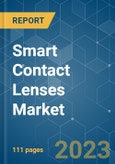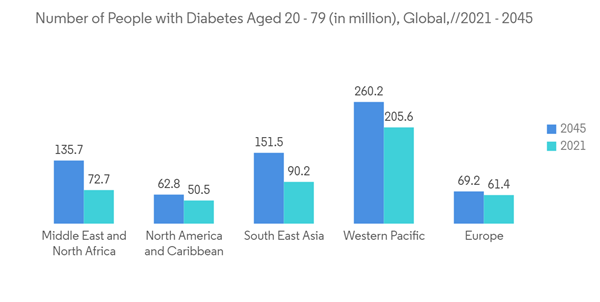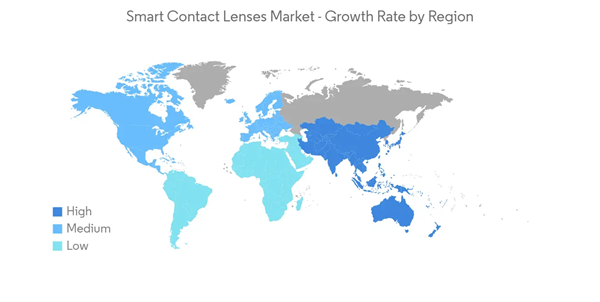The impact of COVID-19 on the smart contact lens market was adverse in the initial phase of the pandemic as the American Academy of Ophthalmology (AAO) released practice guidelines advising ophthalmologists to cease providing any treatment other than urgent and emergent care. The eye consultations were postponed or limited worldwide. For instance, according to data published in August 2020 by the CDC and the AAO, there was a nearly 80% decrease in ophthalmology visits in the United States. However, owing to the recommencement of ophthalmology practices and procedures worldwide, the market recovered growth post-pandemic.
The rising burden of diabetes leading to eye disorders is expected to drive the demand for smart contact lenses for the monitoring of intraocular pressure, which is significantly contributing to the market growth. For instance, as per a November 2021 article published in Ophthalmology Journal, among individuals with diabetes, the global prevalence for diabetic retinopathy was 22.27%, for vision-threatening DR (VTDR) was 6.17% and 4.07% for clinically significant macular edema. The high burden of such diseases is expected to expedite the R&D process for the development of innovative smart contact lenses, driving the market growth.
Furthermore, a smart contact lens is harnessed as a personal healthcare platform for glaucoma and other ocular diseases. According to the WHO report published in October 2022, globally, at least 2.2 billion people have near or distant vision impairment. There are 1 billion people worldwide, 88.4 million of whom have moderate or severe distance vision impairment or blindness due to untreated refractive error, 94 million have cataracts, 8 million have age-related macular degeneration, 7.7 million have glaucoma, 3.9 million of whom have diabetic retinopathy, and 88.4 million more who have age-related macular degeneration due to untreated presbyopia. The high burden of glaucoma, presbyopia, and other vision-related disorders is expected to propel the utility of smart contact lenses, thereby propelling the market growth.
Additionally, the rising research developments and partnerships related to the development of innovative smart contact lenses are driving the market growth. For instance, according to a March 2022 update, in South Korea, a POSTECH research team, in collaboration with doctors of PHI BIOMED Co., developed a smart contact lens-type wearable device to prevent diabetic retinopathy and treat it in its early stages. Such innovative product development and marketing are expected to propel market growth.
Thus, the abovementioned factors indicate the growing burden of eye disorders and advancements in smart contact lens technology that will drive the demand for smart contact lenses over the forecast period. However, the high cost of smart contact lenses and the lack of awareness about these lenses are the major factors restraining the market's growth.
Smart Contact Lenses Market Trends
Continuous Glucose Monitoring Segment is Expected to Hold a Significant Market Share in the Smart Contact Lenses Market
The continuous glucose monitoring segment is expected to hold a significant share of the market. The smart contact lens aims to help diabetes patients by continuously measuring the glucose level in their tears. Miniaturized sensors and wireless chips are built into these lenses to track physiological factors such as intraocular pressure in people with diabetes. Thus, monitoring glucose levels in real-time aids in making informed daily decisions about balancing food, physical activity, and medicine.The major factors fuelling the segment's growth are an increase in research and development activities, technological advancements in the field of ophthalmology, and the growing adoption of smart contact lenses among the diabetic population.
For instance, as per an article published in June 2021 in the National Library of Medicine, recent advances in the development of smart contact lenses for biomedical purposes combine continuous glucose monitoring with an on-demand flexible drug delivery system for the treatment of diabetic retinopathy. Another article published in Frontiers in Medicine Journal in April 2022 stated that extensive research efforts are being devoted to developing smart contact lenses for continual glucose detection. Such studies highlight the significance of smart contact lenses in continuous glucose monitoring. Thus, more studies with positive outcomes are leading to product approvals, which, in turn, contribute to the segment's growth over the coming period.
Furthermore, the technological advancements in smart contact lenses are also contributing to segment growth. For instance, in May 2022, the research published in Advanced Materials demonstrated that smart contact lenses could accurately monitor increasing and decreasing blood glucose levels with 94.9% acceptable data in diabetic and normal rabbits. Such research studies and research activities are projected to boost the demand for smart contact lenses for glucose monitoring purposes, thereby boosting the market growth during the forecast period.
North America is Expected to Hold a Significant Market Share Over The Forecast Period
North America is expected to hold a significant share of the market. It can be attributed to factors such as the increasing number of patient visits seeking eye care treatment, a surge in awareness regarding the commercial availability of products, a rising number of research and development activities, and the strong presence of market players in the region.The high burden of glaucoma in the region is contributing to market growth since the intraocular pressure levels can be effectively monitored and controlled by advanced smart contact lenses. For instance, as per a July 2021 update by the BrightFocus Foundation, more than three million Americans are living with glaucoma, 2.7 million of whom aged 40 and older are affected by its most common form, open-angle glaucoma. The same source stated that glaucoma is a leading cause of blindness among African Americans and Hispanics in the United States. Also, in January 2021, the Canadian Ophthalmological Society, during glaucoma awareness month, stated that glaucoma affects more than 800,000 Canadians annually. Hence the rise in the burden of eye-related diseases increases the demand for smart contact lenses for intraocular pressure monitoring, which is expected to propel the market growth in the region.
Additionally, several strategic initiatives undertaken by prominent players are contributing to the market's growth. For instance, in January 2021, InWith, a corporation that specializes in the embedding of microelectronic technology in hydrogel devices, demonstrated its incredible smart contact lenses at the CES event 2021, opening a new door for the future of computerized applications for augmented reality (AR) in soft contact lenses. Owing to the technological advancements in smart contact lenses and their advantages in monitoring applications, the studied market is expected to witness significant growth over the forecast period.
Smart Contact Lenses Industry Overview
The smart contact lenses market is competitive with several global and international players. The key players are adopting different growth strategies to enhance their market presence, such as partnerships, agreements, collaborations, new product launches, geographical expansions, mergers, and acquisitions. Some of the key players in the market are Sensimed, Mojo Vision, Innovega Inc., InWith Corporation, and Johnson & Johnson, among others market players.Additional Benefits:
- The market estimate (ME) sheet in Excel format
- 3 months of analyst support
This product will be delivered within 2 business days.
Table of Contents
Companies Mentioned (Partial List)
A selection of companies mentioned in this report includes, but is not limited to:
- Sensimed
- Mojo Vision
- Innovega Inc.
- InWith Corporation
- Johnson & Johnson
- Samsung
- Sony Group Corporation
- EP Global Communications Inc (EPGL)
- International Business Machines (IBM) Corporation
- Huawei Biomed
- RaayonNova LLC










